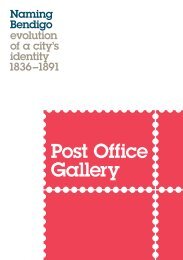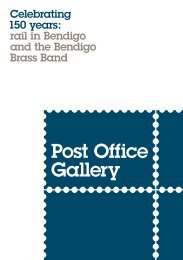Theatrical traditions: stage and screen in Bendigo
This electronic publication accompanies the exhibition Theatrical traditions: stage and screen in Bendigo. Western theatrical traditions came to Bendigo with fortune seekers in the 1850s. Since then, everything from amateur to professional, Shakespeare, opera, live music, eisteddfods, Vaudeville, musicals and comedy have graced the many stages in Bendigo. The beginning of the 20th century heralded the dawn of the motion picture, which by the middle of the century was the most popular form of entertainment. Existing Bendigo theatres quickly adapted and numerous purpose built picture theatres were constructed. Theatrical traditions: stage and screen in Bendigo looked at key moments, venues and people in the evolution of such entertainment in Bendigo.
This electronic publication accompanies the exhibition Theatrical traditions: stage and screen in Bendigo.
Western theatrical traditions came to Bendigo with fortune seekers in the 1850s. Since then, everything from amateur to professional, Shakespeare, opera, live music, eisteddfods, Vaudeville, musicals and comedy have graced the many stages in Bendigo. The beginning of the 20th century heralded the dawn of the motion picture, which by the middle of the century was the most popular form of entertainment. Existing Bendigo theatres quickly adapted and numerous purpose built picture theatres were constructed. Theatrical traditions: stage and screen in Bendigo looked at key moments, venues and people in the evolution of such entertainment in Bendigo.
Create successful ePaper yourself
Turn your PDF publications into a flip-book with our unique Google optimized e-Paper software.
‘Joseph <strong>and</strong> the<br />
Amaz<strong>in</strong>g technicolor<br />
Dreamcoat marked<br />
the company’s 100th<br />
musical production..’<br />
22<br />
At the same time, the <strong>Bendigo</strong><br />
Theatre Company (formally <strong>Bendigo</strong><br />
Operatic Society) began present<strong>in</strong>g<br />
regular performances at the Capital<br />
Theatre. Established <strong>in</strong> 1952, they<br />
first performed The Chocolate Soldier,<br />
cont<strong>in</strong>u<strong>in</strong>g to <strong>stage</strong> two or three<br />
musical theatre pieces a year until the<br />
Capital closed <strong>in</strong> the 1970s. In the early<br />
1980s, the Society changed its name to<br />
the <strong>Bendigo</strong> Theatre Company <strong>and</strong><br />
cont<strong>in</strong>ued to perform on ancillary<br />
<strong>stage</strong>s across <strong>Bendigo</strong>. In 1991, they<br />
<strong>stage</strong>d the musical South Pacific mak<strong>in</strong>g<br />
their ‘triumphant return’ to the Capital<br />
<strong>stage</strong>. Their June 1997 performance<br />
of Joseph <strong>and</strong> the Amaz<strong>in</strong>g technicolor<br />
Dreamcoat marked the company’s 100th<br />
musical production. 47<br />
Over the years, countless locals have<br />
dedicated passion <strong>and</strong> energy to the<br />
longevity <strong>and</strong> success of community<br />
theatre <strong>in</strong> <strong>Bendigo</strong>. In addition to<br />
the <strong>Bendigo</strong> Theatre Company, local<br />
companies such as CT Productions,<br />
<strong>Bendigo</strong> Theatre <strong>and</strong> Arts Inc (formally<br />
<strong>Bendigo</strong> Community Theatre)<br />
cont<strong>in</strong>ue to ma<strong>in</strong>ta<strong>in</strong> a high profile<br />
<strong>in</strong> the community impact<strong>in</strong>g not only<br />
audiences, but also generations of<br />
performers <strong>and</strong> support crew.<br />
BENDIGO REGIONAL ARTS CENTRE<br />
As mentioned, performances cont<strong>in</strong>ued<br />
to take place at the Capital until the<br />
ag<strong>in</strong>g theatre closed to the public <strong>in</strong> the<br />
1970s. With the Pr<strong>in</strong>cess demolished<br />
<strong>and</strong> the Capital closed, local audiences<br />
<strong>and</strong> theatre companies were left with<br />
few options. Despite their tenacity to<br />
keep local theatre alive, alternative<br />
venues were <strong>in</strong>adequate. The need<br />
for a premier theatre <strong>in</strong> <strong>Bendigo</strong> was<br />
once aga<strong>in</strong> apparent. The idea of a<br />
Regional Arts Centre was flagged <strong>and</strong><br />
passionately lobbied. What ensued over<br />
the follow<strong>in</strong>g decade was a political<br />
battle that polarised the community. 48<br />
In the mid-1970s, several sites were<br />
considered for the Arts Centre,<br />
<strong>in</strong>clud<strong>in</strong>g the old Plaza theatre <strong>and</strong><br />
a site <strong>in</strong>corporat<strong>in</strong>g the Shamrock<br />
Hotel. By the middle of the 1980s, the<br />
Capital Theatre had been identified<br />
as the most suitable site <strong>and</strong> its<br />
restoration <strong>and</strong> reopen<strong>in</strong>g became the<br />
focus of passionate local campaigners.<br />
A Community Arts Work<strong>in</strong>g Party<br />
was formed <strong>and</strong> consensus between<br />
the five <strong>Bendigo</strong> municipalities to<br />
purchase the Capital build<strong>in</strong>g <strong>and</strong><br />
support the enterprise was sought.<br />
The State Government committed

















